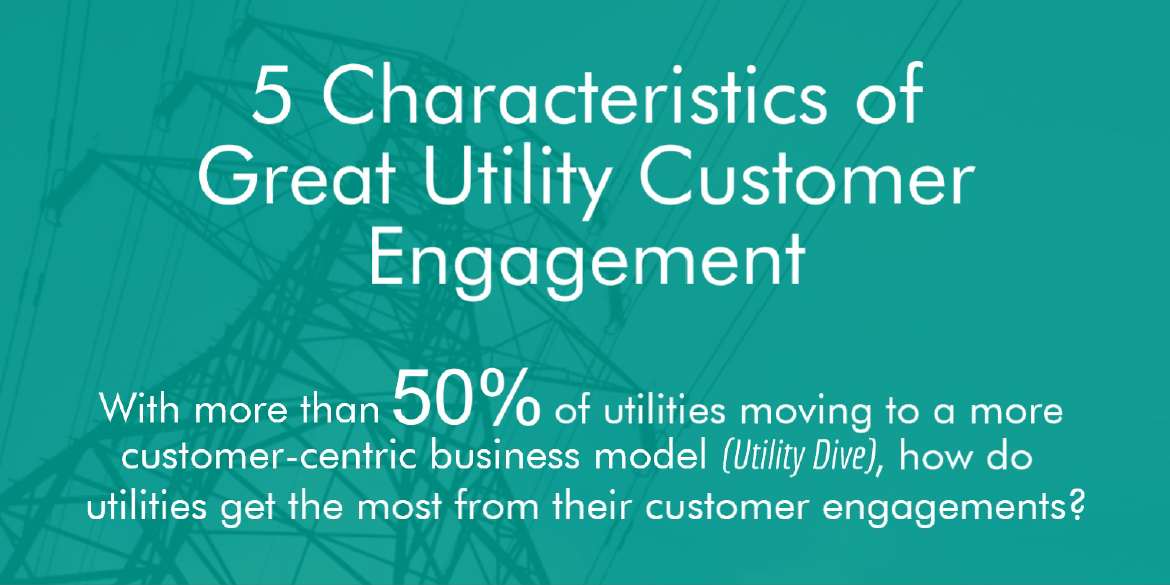“The utilities that succeed in educating their residential customers may be [the best positioned not only] to survive, but [also to] thrive in the new customer-centric electricity landscape that is now taking shape.” – 2015 Utility Residential Customer Education Survey, Utility Dive
This statement was a key finding of a survey of 144 power-sector executives conducted by Utility Dive for NTC Corporate. This same report also pointed out that utilities may be falling short, with only 2% of surveyed utilities believing they have great customer outreach programs.
Not to worry, the future should be bright. According to the Utility Dive report, 71% of utility executives expect funding for residential customer education programs to increase over the next five years. However, without rethinking the core characteristics of successful customer engagement, this funding will almost certainly fall short of achieving its goals. The following five characteristics can mean the difference between thriving—or failing—utility customer engagement initiatives.

- Get personal
Every utility customer is unique, and they want an experience tailored specifically to them. As described in a recent Accenture research study “The New Energy Consumer – Architecting for the Future,” as other industries strive for greater personalization, consumers are becoming accustomed to more choice in terms of solutions, services and methods of interaction.When it comes to informing customers’ energy decisions such as solar, electric vehicles or energy efficiency, personalization goes beyond delivering a great experience—it must factor in user-specific information such as location and energy use behavior, as they can drive drastically varying energy and financial results. Personalization is critical for these types of analyses.

- Keep it interactive
Today, direct mail and email are the most commonly used channels for customer education. However, the Accenture study shows that today’s customers want to interact with utilities through low-touch digital channels.This creates an opportunity for utilities to more deeply engage customers through self-service digital interaction at the precise times when customers are thinking about their utility bill. Not only do self-service tools lower customer service costs, they also satisfy the customer’s desire to proactively manage their own transactions. According to the Accenture study, self-service now represents a key determinant of satisfaction and loyalty, and is a primary enabler when developing and maintaining relationships.

- Show return on investment
According to the Utility Dive study, 72% of utilities believe that financial incentives are the most effective motivator for driving energy decisions. The study also points out, however, that awareness is a bigger problem—if customers don’t know about financial incentives, then they aren’t effective.As technologies such as solar grow out of the early adopter phase, saving money becomes the primary decision driver for most customers. It’s imperative that utilities provide an objective financial analysis, including incentives and the overall return on investment for various forms of financing, such as cash, loan, lease or PPA.

- Make it understandable
New energy technologies and financial terms and concepts can be complicated and confusing for many customers. New software technologies that take advantage of customer-specific data can handle the complicated analytics for the customer, and present results in a way that is both meaningful and easy to understand.

- Communicate options
There is no one-size-fits-all when it comes to customer energy decisions. Certain technologies or forms of financing might make sense for one customer but not another based on their location, behavior or financial status. Effective customer engagement will inform customers of all options available to them, ensuring the most informed decision.This means providing information on a variety of energy options. For example, a customer looking into rooftop solar could be informed that switching to an electric vehicle might actually provide greater savings.
Click to access the “Five Characteristics of Great Utility Customer Engagement” infographic.
Using the web to create thriving customer engagement initiatives
Energy efficiency and rooftop solar are major drivers in the shift to a more consumer-centric business model. Of the utilities surveyed in the Utility Dive study, 97% said they see distributed energy changing the way they educate residential customers over the next five years.
The evolution of the energy industry that is enabling customers to engage with their energy use is opening up new opportunities—and new challenges—for utilities. Traditional methods of reaching consumers (direct mail, email and telemarketing) aren’t able to support these interdependent core engagement characteristics. Taking engagement online—providing self-service interactions when and where it’s convenient for the consumer—is the key to a thriving customer engagement strategy.
“By becoming oriented around virtual interaction, energy providers can not only deliver on changing consumer preferences but also increase customer satisfaction and address a range of operational and efficiency goals.” – Accenture, The New Energy Consumer – Architecting for the Future
Setting a new standard for customer engagement with WattPlan®
Utilities looking to the future are implementing online software tools such as WattPlan to proactively engage customers, when and where they want, with highly-personalized energy guidance.
By combining customer-specific data with the most advanced technical models, WattPlan provides instant access to information directly from a utility’s website. The interactive format allows customers to change parameters, dive deeper into specific areas, and compare the return on investment for various forms of financing (i.e., cash, loan or lease) or for various technologies (i.e., solar, electric vehicle or energy efficiency).
See WattPlan in action in the video below, or Contact Us for more information about taking utility customer engagement programs to a new level.
